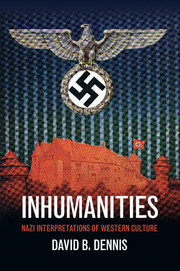Book contents
- Frontmatter
- Contents
- List of Illustrations
- Acknowledgments
- Introduction
- Part I Foundations of Nazi Cultural History
- Part II Blind to the Light
- Part III Modern Dilemmas
- Part IV “Holy” War and Weimar “Crisis”
- Part V Nazi “Solutions”
- 16 “Honor your German Masters”
- 17 The Nazi “Renaissance”
- 18 Kultur at War
- Conclusion
- Notes
- Index
Conclusion
Published online by Cambridge University Press: 05 October 2012
- Frontmatter
- Contents
- List of Illustrations
- Acknowledgments
- Introduction
- Part I Foundations of Nazi Cultural History
- Part II Blind to the Light
- Part III Modern Dilemmas
- Part IV “Holy” War and Weimar “Crisis”
- Part V Nazi “Solutions”
- 16 “Honor your German Masters”
- 17 The Nazi “Renaissance”
- 18 Kultur at War
- Conclusion
- Notes
- Index
Summary
In September 1937, after a summer in which the Nazi regime formalized its anti-modernist art policy with the dual “Degenerate” and “Great German” art exhibits in Munich, the party held its annual rally in Nürnberg. By then the polished apotheosis of Nazi ritual, the 1937 Nürnberg rally was marked by what many still consider to have been the most “sublime” spectacle born of Nazi culture: the so-called “cathedral of light” (Figure C.1). Albert Speer designed the effect by surrounding the massive Zeppelin Field with 152 anti-aircraft searchlights, training them first vertically and then on a converging spot high over the site. From beneath this “dome of light” (Lichtdom), as ranks of party members gazed upward, they were presented with a massive representation of the ordered environment promised by the Nazi “world view.”
During their visit to the rally, attendees could also purchase mementos of their heightened Nazi experience in the form of bric-a-brac familiar to anyone who attends a modern mass event. Among the items for sale was a postcard designed to capture the idealized totality of the rally experience (Figure C.2). The postcard featured a glowing image of Nürnberg’s Imperial Castle (Kaiserburg), built and rebuilt for the Holy Roman Emperors between the eleventh and sixteenth centuries, that loomed over the city’s center. Sprouting prominently from one of the castle’s towers is the flag of National Socialism. Superimposed over the castle and dominating the composition is a monumental Nazi eagle derived from German national symbolism and now clutching a bright swastika wreathed in laurels. In the background is a stylized representation of the vertical pattern formed by the beams of the Lichtdom searchlights that pierced the night sky.
- Type
- Chapter
- Information
- InhumanitiesNazi Interpretations of Western Culture, pp. 452 - 463Publisher: Cambridge University PressPrint publication year: 2012

